Analysis of Case Management: Complex Case Requirements Assessment 1
VerifiedAdded on 2022/11/25
|13
|3014
|439
Report
AI Summary
This report comprehensively examines the intricacies of case management, focusing on various models such as brokerage, clinical, and strength-based approaches, detailing their strengths and the roles of case managers within each. It explores the benefits of implementing principles like advocacy, collaboration, and strengths-based approaches when planning complex services and working with multiple service providers. The report also outlines the requirements of evidence-based practice, provides examples of community service standards, policies, and legislation, and addresses potential client confusions like jargon and funding complexities. Furthermore, it covers the impacts of generational abuse and welfare dependency, funding options, and situations requiring client referrals. It emphasizes the importance of care coordinators in identifying service providers, recognizing risk indicators (child abuse, domestic violence, suicide, and elder abuse), and addressing family structures' impact on communication. The report also discusses preventing service duplication, resolving common client issues, prioritizing client needs, and the essential components of a case management plan to ensure expected outcomes are met.
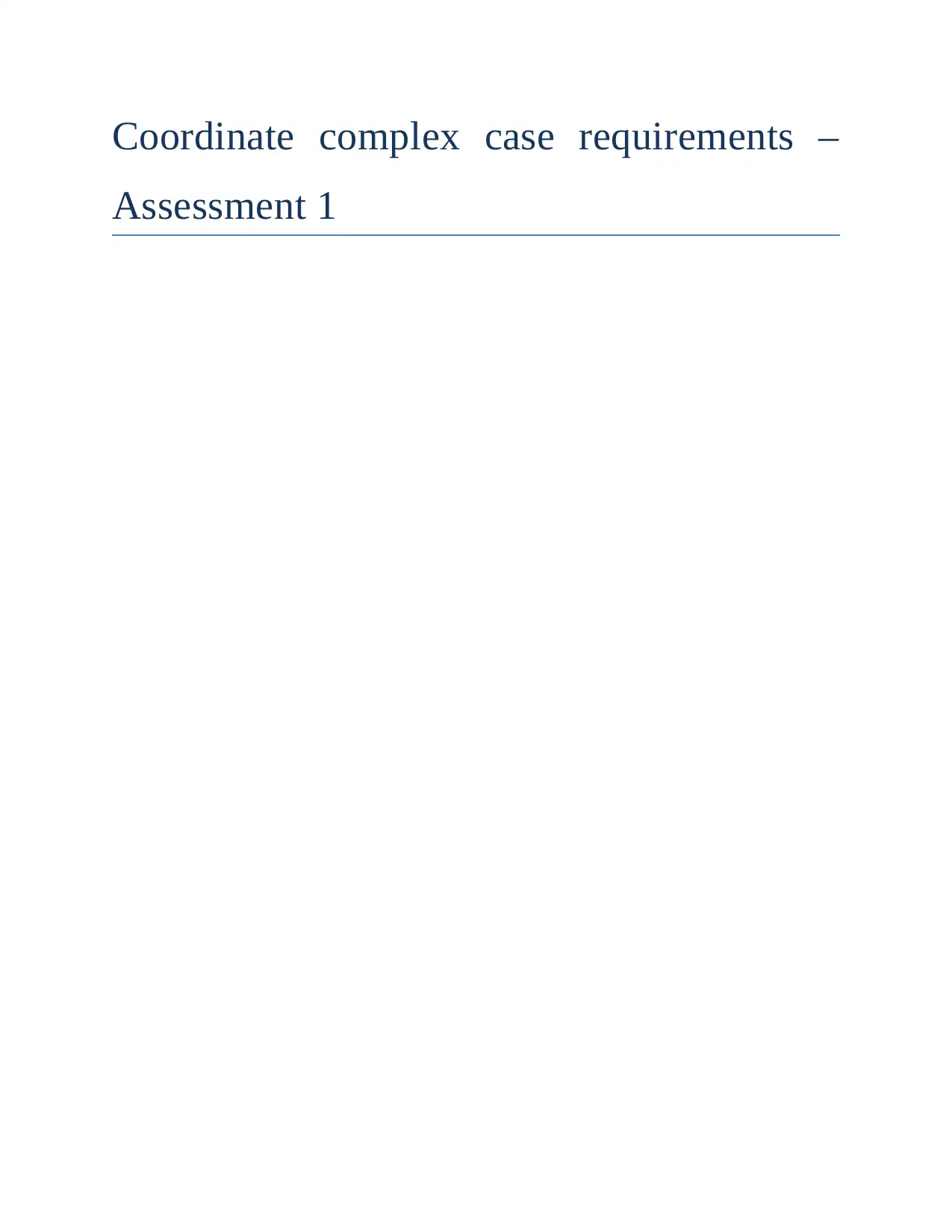
Coordinate complex case requirements –
Assessment 1
Assessment 1
Paraphrase This Document
Need a fresh take? Get an instant paraphrase of this document with our AI Paraphraser
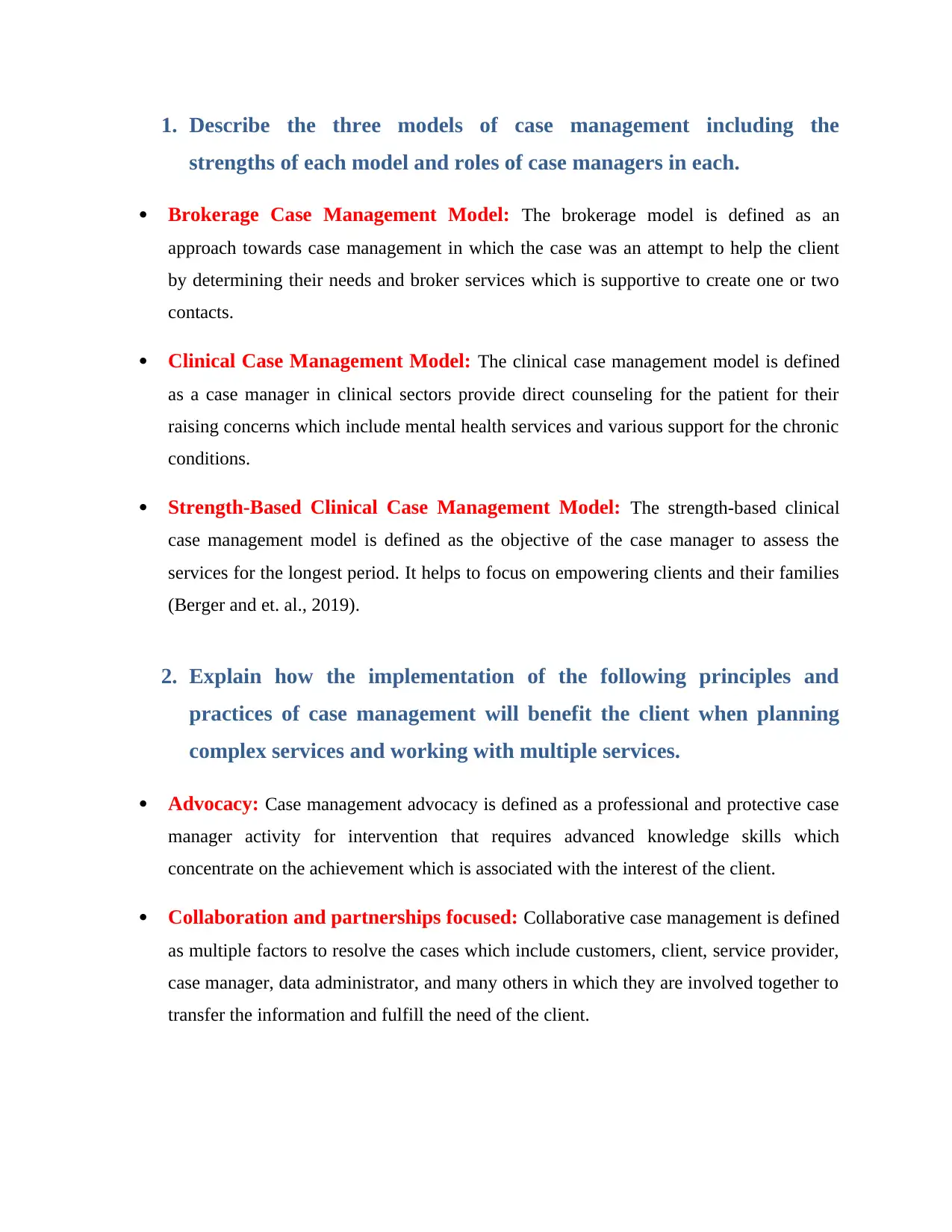
1. Describe the three models of case management including the
strengths of each model and roles of case managers in each.
Brokerage Case Management Model: The brokerage model is defined as an
approach towards case management in which the case was an attempt to help the client
by determining their needs and broker services which is supportive to create one or two
contacts.
Clinical Case Management Model: The clinical case management model is defined
as a case manager in clinical sectors provide direct counseling for the patient for their
raising concerns which include mental health services and various support for the chronic
conditions.
Strength-Based Clinical Case Management Model: The strength-based clinical
case management model is defined as the objective of the case manager to assess the
services for the longest period. It helps to focus on empowering clients and their families
(Berger and et. al., 2019).
2. Explain how the implementation of the following principles and
practices of case management will benefit the client when planning
complex services and working with multiple services.
Advocacy: Case management advocacy is defined as a professional and protective case
manager activity for intervention that requires advanced knowledge skills which
concentrate on the achievement which is associated with the interest of the client.
Collaboration and partnerships focused: Collaborative case management is defined
as multiple factors to resolve the cases which include customers, client, service provider,
case manager, data administrator, and many others in which they are involved together to
transfer the information and fulfill the need of the client.
strengths of each model and roles of case managers in each.
Brokerage Case Management Model: The brokerage model is defined as an
approach towards case management in which the case was an attempt to help the client
by determining their needs and broker services which is supportive to create one or two
contacts.
Clinical Case Management Model: The clinical case management model is defined
as a case manager in clinical sectors provide direct counseling for the patient for their
raising concerns which include mental health services and various support for the chronic
conditions.
Strength-Based Clinical Case Management Model: The strength-based clinical
case management model is defined as the objective of the case manager to assess the
services for the longest period. It helps to focus on empowering clients and their families
(Berger and et. al., 2019).
2. Explain how the implementation of the following principles and
practices of case management will benefit the client when planning
complex services and working with multiple services.
Advocacy: Case management advocacy is defined as a professional and protective case
manager activity for intervention that requires advanced knowledge skills which
concentrate on the achievement which is associated with the interest of the client.
Collaboration and partnerships focused: Collaborative case management is defined
as multiple factors to resolve the cases which include customers, client, service provider,
case manager, data administrator, and many others in which they are involved together to
transfer the information and fulfill the need of the client.
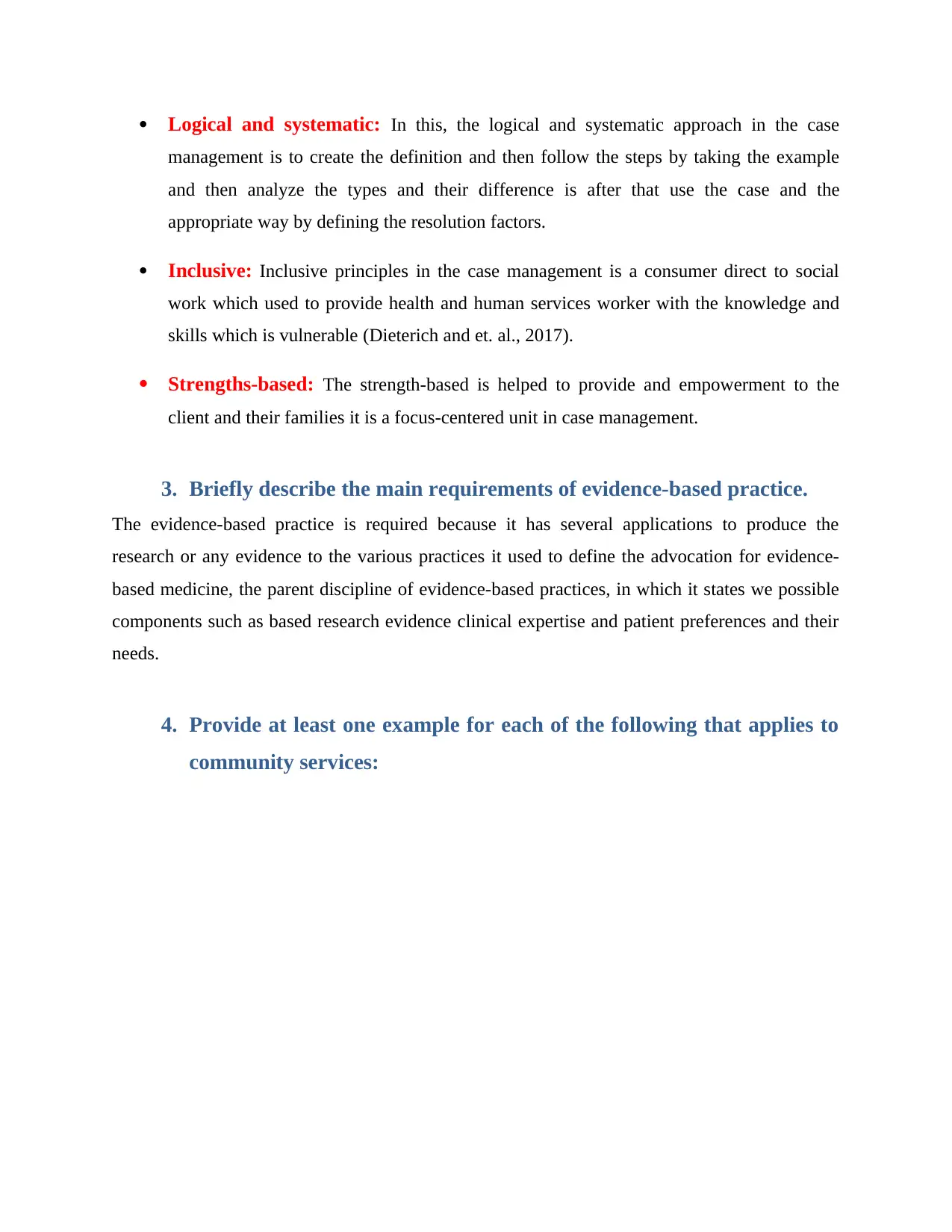
Logical and systematic: In this, the logical and systematic approach in the case
management is to create the definition and then follow the steps by taking the example
and then analyze the types and their difference is after that use the case and the
appropriate way by defining the resolution factors.
Inclusive: Inclusive principles in the case management is a consumer direct to social
work which used to provide health and human services worker with the knowledge and
skills which is vulnerable (Dieterich and et. al., 2017).
Strengths-based: The strength-based is helped to provide and empowerment to the
client and their families it is a focus-centered unit in case management.
3. Briefly describe the main requirements of evidence-based practice.
The evidence-based practice is required because it has several applications to produce the
research or any evidence to the various practices it used to define the advocation for evidence-
based medicine, the parent discipline of evidence-based practices, in which it states we possible
components such as based research evidence clinical expertise and patient preferences and their
needs.
4. Provide at least one example for each of the following that applies to
community services:
management is to create the definition and then follow the steps by taking the example
and then analyze the types and their difference is after that use the case and the
appropriate way by defining the resolution factors.
Inclusive: Inclusive principles in the case management is a consumer direct to social
work which used to provide health and human services worker with the knowledge and
skills which is vulnerable (Dieterich and et. al., 2017).
Strengths-based: The strength-based is helped to provide and empowerment to the
client and their families it is a focus-centered unit in case management.
3. Briefly describe the main requirements of evidence-based practice.
The evidence-based practice is required because it has several applications to produce the
research or any evidence to the various practices it used to define the advocation for evidence-
based medicine, the parent discipline of evidence-based practices, in which it states we possible
components such as based research evidence clinical expertise and patient preferences and their
needs.
4. Provide at least one example for each of the following that applies to
community services:
⊘ This is a preview!⊘
Do you want full access?
Subscribe today to unlock all pages.

Trusted by 1+ million students worldwide
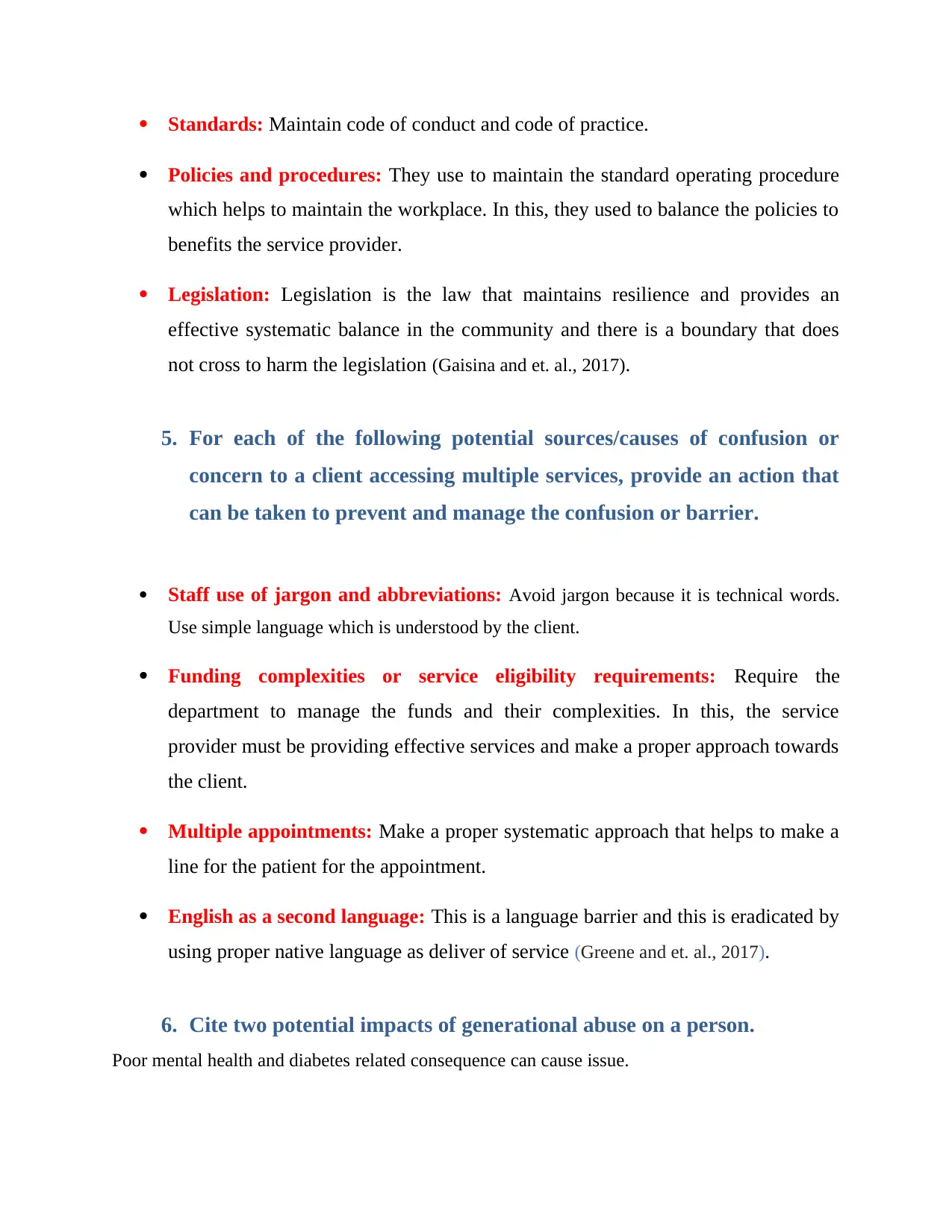
Standards: Maintain code of conduct and code of practice.
Policies and procedures: They use to maintain the standard operating procedure
which helps to maintain the workplace. In this, they used to balance the policies to
benefits the service provider.
Legislation: Legislation is the law that maintains resilience and provides an
effective systematic balance in the community and there is a boundary that does
not cross to harm the legislation (Gaisina and et. al., 2017).
5. For each of the following potential sources/causes of confusion or
concern to a client accessing multiple services, provide an action that
can be taken to prevent and manage the confusion or barrier.
Staff use of jargon and abbreviations: Avoid jargon because it is technical words.
Use simple language which is understood by the client.
Funding complexities or service eligibility requirements: Require the
department to manage the funds and their complexities. In this, the service
provider must be providing effective services and make a proper approach towards
the client.
Multiple appointments: Make a proper systematic approach that helps to make a
line for the patient for the appointment.
English as a second language: This is a language barrier and this is eradicated by
using proper native language as deliver of service (Greene and et. al., 2017).
6. Cite two potential impacts of generational abuse on a person.
Poor mental health and diabetes related consequence can cause issue.
Policies and procedures: They use to maintain the standard operating procedure
which helps to maintain the workplace. In this, they used to balance the policies to
benefits the service provider.
Legislation: Legislation is the law that maintains resilience and provides an
effective systematic balance in the community and there is a boundary that does
not cross to harm the legislation (Gaisina and et. al., 2017).
5. For each of the following potential sources/causes of confusion or
concern to a client accessing multiple services, provide an action that
can be taken to prevent and manage the confusion or barrier.
Staff use of jargon and abbreviations: Avoid jargon because it is technical words.
Use simple language which is understood by the client.
Funding complexities or service eligibility requirements: Require the
department to manage the funds and their complexities. In this, the service
provider must be providing effective services and make a proper approach towards
the client.
Multiple appointments: Make a proper systematic approach that helps to make a
line for the patient for the appointment.
English as a second language: This is a language barrier and this is eradicated by
using proper native language as deliver of service (Greene and et. al., 2017).
6. Cite two potential impacts of generational abuse on a person.
Poor mental health and diabetes related consequence can cause issue.
Paraphrase This Document
Need a fresh take? Get an instant paraphrase of this document with our AI Paraphraser
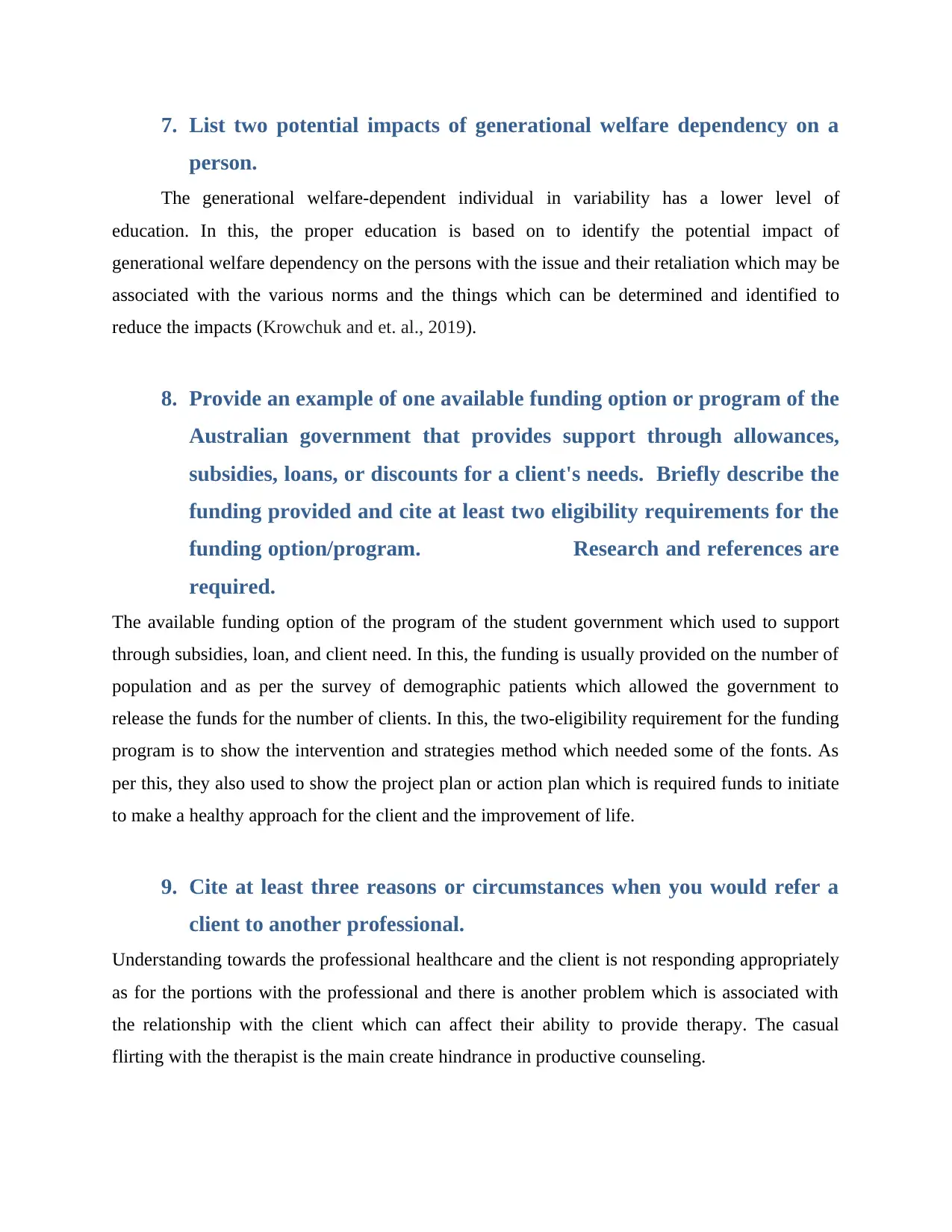
7. List two potential impacts of generational welfare dependency on a
person.
The generational welfare-dependent individual in variability has a lower level of
education. In this, the proper education is based on to identify the potential impact of
generational welfare dependency on the persons with the issue and their retaliation which may be
associated with the various norms and the things which can be determined and identified to
reduce the impacts (Krowchuk and et. al., 2019).
8. Provide an example of one available funding option or program of the
Australian government that provides support through allowances,
subsidies, loans, or discounts for a client's needs. Briefly describe the
funding provided and cite at least two eligibility requirements for the
funding option/program. Research and references are
required.
The available funding option of the program of the student government which used to support
through subsidies, loan, and client need. In this, the funding is usually provided on the number of
population and as per the survey of demographic patients which allowed the government to
release the funds for the number of clients. In this, the two-eligibility requirement for the funding
program is to show the intervention and strategies method which needed some of the fonts. As
per this, they also used to show the project plan or action plan which is required funds to initiate
to make a healthy approach for the client and the improvement of life.
9. Cite at least three reasons or circumstances when you would refer a
client to another professional.
Understanding towards the professional healthcare and the client is not responding appropriately
as for the portions with the professional and there is another problem which is associated with
the relationship with the client which can affect their ability to provide therapy. The casual
flirting with the therapist is the main create hindrance in productive counseling.
person.
The generational welfare-dependent individual in variability has a lower level of
education. In this, the proper education is based on to identify the potential impact of
generational welfare dependency on the persons with the issue and their retaliation which may be
associated with the various norms and the things which can be determined and identified to
reduce the impacts (Krowchuk and et. al., 2019).
8. Provide an example of one available funding option or program of the
Australian government that provides support through allowances,
subsidies, loans, or discounts for a client's needs. Briefly describe the
funding provided and cite at least two eligibility requirements for the
funding option/program. Research and references are
required.
The available funding option of the program of the student government which used to support
through subsidies, loan, and client need. In this, the funding is usually provided on the number of
population and as per the survey of demographic patients which allowed the government to
release the funds for the number of clients. In this, the two-eligibility requirement for the funding
program is to show the intervention and strategies method which needed some of the fonts. As
per this, they also used to show the project plan or action plan which is required funds to initiate
to make a healthy approach for the client and the improvement of life.
9. Cite at least three reasons or circumstances when you would refer a
client to another professional.
Understanding towards the professional healthcare and the client is not responding appropriately
as for the portions with the professional and there is another problem which is associated with
the relationship with the client which can affect their ability to provide therapy. The casual
flirting with the therapist is the main create hindrance in productive counseling.
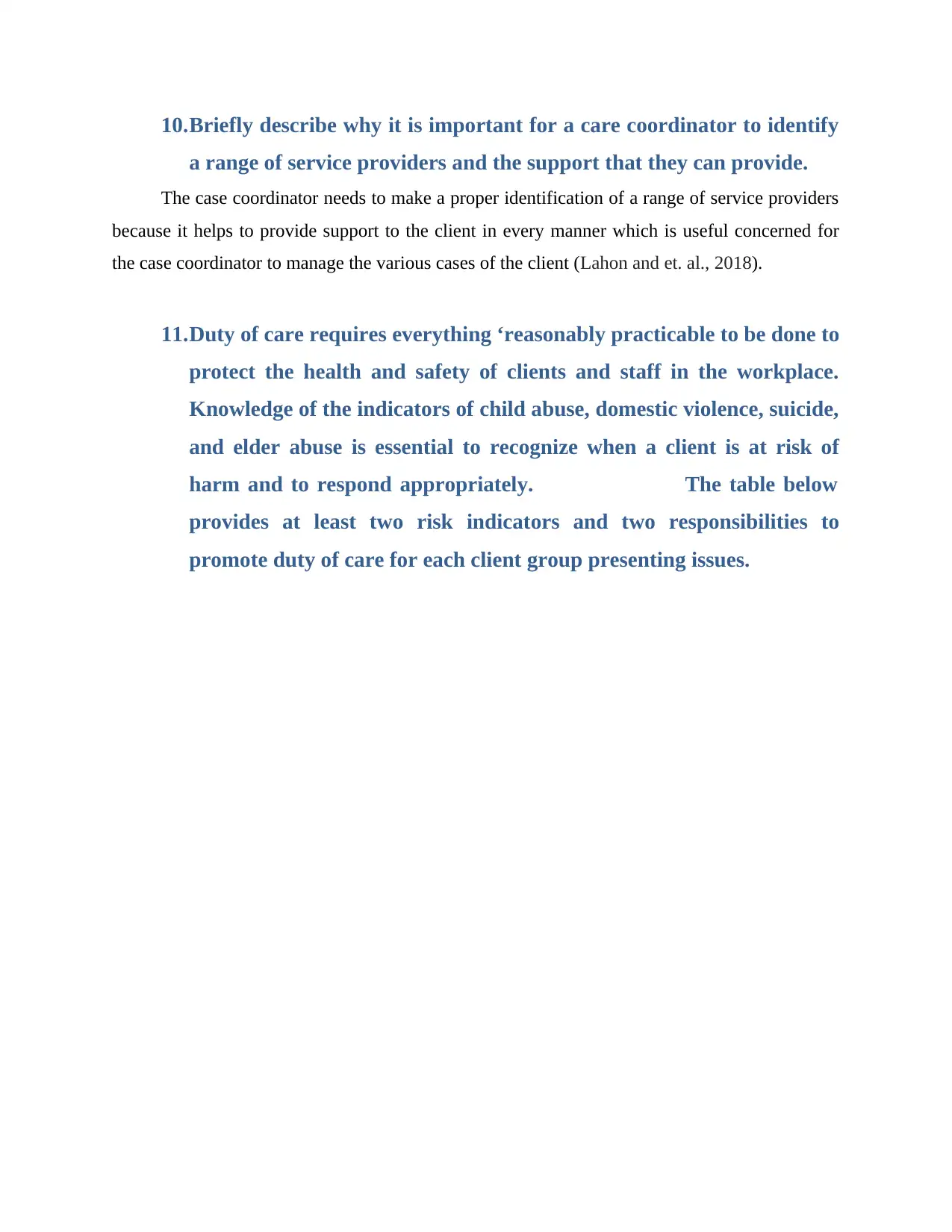
10.Briefly describe why it is important for a care coordinator to identify
a range of service providers and the support that they can provide.
The case coordinator needs to make a proper identification of a range of service providers
because it helps to provide support to the client in every manner which is useful concerned for
the case coordinator to manage the various cases of the client (Lahon and et. al., 2018).
11.Duty of care requires everything ‘reasonably practicable to be done to
protect the health and safety of clients and staff in the workplace.
Knowledge of the indicators of child abuse, domestic violence, suicide,
and elder abuse is essential to recognize when a client is at risk of
harm and to respond appropriately. The table below
provides at least two risk indicators and two responsibilities to
promote duty of care for each client group presenting issues.
a range of service providers and the support that they can provide.
The case coordinator needs to make a proper identification of a range of service providers
because it helps to provide support to the client in every manner which is useful concerned for
the case coordinator to manage the various cases of the client (Lahon and et. al., 2018).
11.Duty of care requires everything ‘reasonably practicable to be done to
protect the health and safety of clients and staff in the workplace.
Knowledge of the indicators of child abuse, domestic violence, suicide,
and elder abuse is essential to recognize when a client is at risk of
harm and to respond appropriately. The table below
provides at least two risk indicators and two responsibilities to
promote duty of care for each client group presenting issues.
⊘ This is a preview!⊘
Do you want full access?
Subscribe today to unlock all pages.

Trusted by 1+ million students worldwide
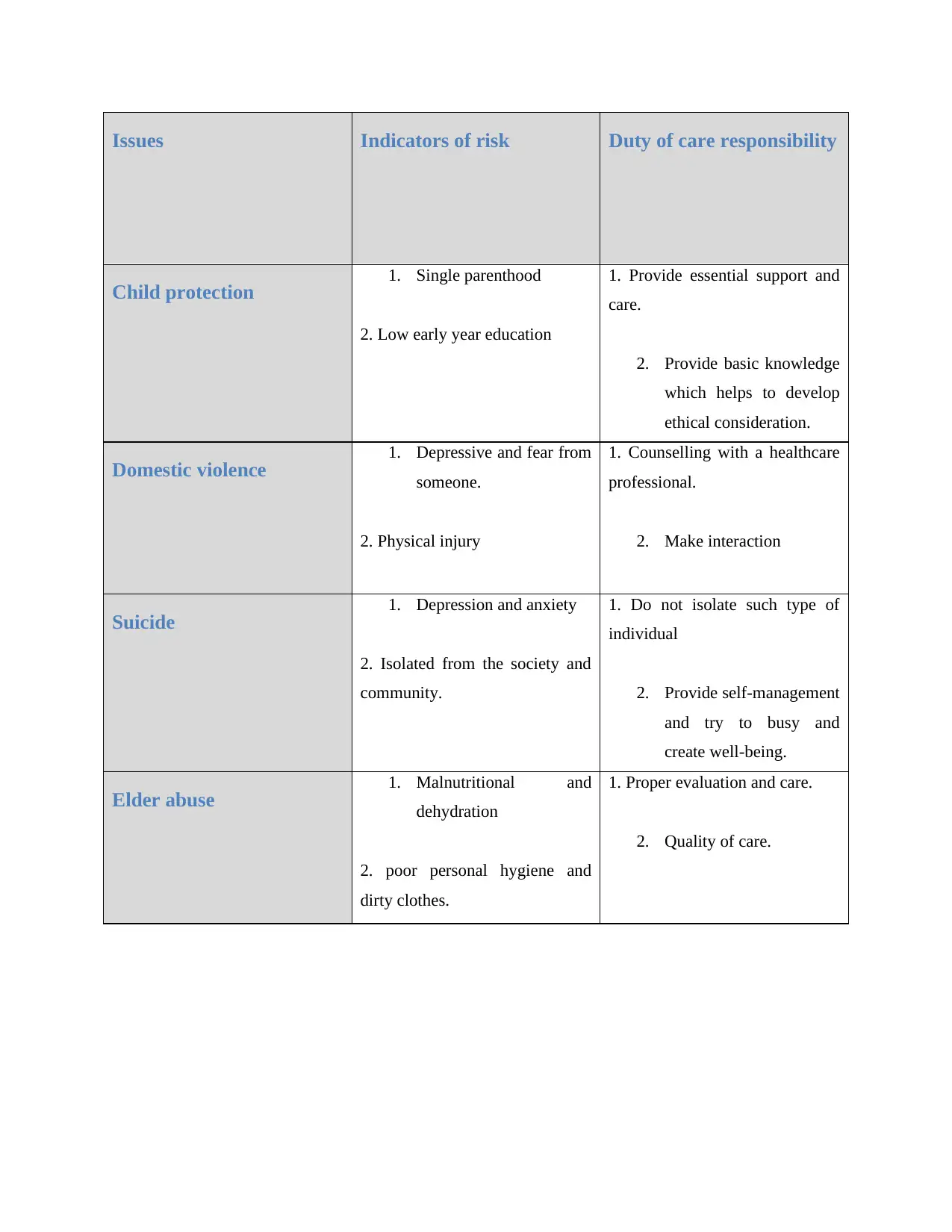
Issues Indicators of risk Duty of care responsibility
Child protection 1. Single parenthood
2. Low early year education
1. Provide essential support and
care.
2. Provide basic knowledge
which helps to develop
ethical consideration.
Domestic violence 1. Depressive and fear from
someone.
2. Physical injury
1. Counselling with a healthcare
professional.
2. Make interaction
Suicide 1. Depression and anxiety
2. Isolated from the society and
community.
1. Do not isolate such type of
individual
2. Provide self-management
and try to busy and
create well-being.
Elder abuse 1. Malnutritional and
dehydration
2. poor personal hygiene and
dirty clothes.
1. Proper evaluation and care.
2. Quality of care.
Child protection 1. Single parenthood
2. Low early year education
1. Provide essential support and
care.
2. Provide basic knowledge
which helps to develop
ethical consideration.
Domestic violence 1. Depressive and fear from
someone.
2. Physical injury
1. Counselling with a healthcare
professional.
2. Make interaction
Suicide 1. Depression and anxiety
2. Isolated from the society and
community.
1. Do not isolate such type of
individual
2. Provide self-management
and try to busy and
create well-being.
Elder abuse 1. Malnutritional and
dehydration
2. poor personal hygiene and
dirty clothes.
1. Proper evaluation and care.
2. Quality of care.
Paraphrase This Document
Need a fresh take? Get an instant paraphrase of this document with our AI Paraphraser
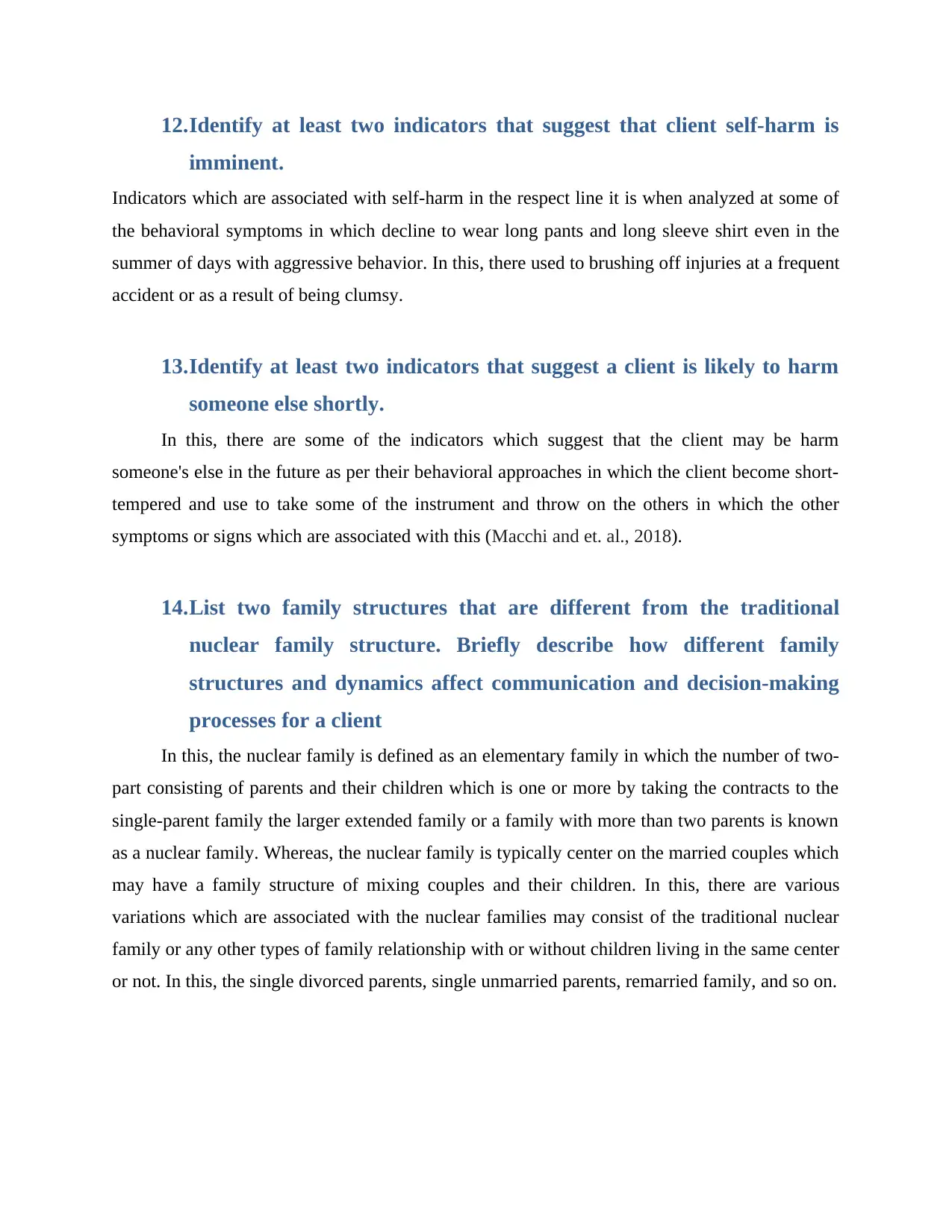
12.Identify at least two indicators that suggest that client self-harm is
imminent.
Indicators which are associated with self-harm in the respect line it is when analyzed at some of
the behavioral symptoms in which decline to wear long pants and long sleeve shirt even in the
summer of days with aggressive behavior. In this, there used to brushing off injuries at a frequent
accident or as a result of being clumsy.
13.Identify at least two indicators that suggest a client is likely to harm
someone else shortly.
In this, there are some of the indicators which suggest that the client may be harm
someone's else in the future as per their behavioral approaches in which the client become short-
tempered and use to take some of the instrument and throw on the others in which the other
symptoms or signs which are associated with this (Macchi and et. al., 2018).
14.List two family structures that are different from the traditional
nuclear family structure. Briefly describe how different family
structures and dynamics affect communication and decision-making
processes for a client
In this, the nuclear family is defined as an elementary family in which the number of two-
part consisting of parents and their children which is one or more by taking the contracts to the
single-parent family the larger extended family or a family with more than two parents is known
as a nuclear family. Whereas, the nuclear family is typically center on the married couples which
may have a family structure of mixing couples and their children. In this, there are various
variations which are associated with the nuclear families may consist of the traditional nuclear
family or any other types of family relationship with or without children living in the same center
or not. In this, the single divorced parents, single unmarried parents, remarried family, and so on.
imminent.
Indicators which are associated with self-harm in the respect line it is when analyzed at some of
the behavioral symptoms in which decline to wear long pants and long sleeve shirt even in the
summer of days with aggressive behavior. In this, there used to brushing off injuries at a frequent
accident or as a result of being clumsy.
13.Identify at least two indicators that suggest a client is likely to harm
someone else shortly.
In this, there are some of the indicators which suggest that the client may be harm
someone's else in the future as per their behavioral approaches in which the client become short-
tempered and use to take some of the instrument and throw on the others in which the other
symptoms or signs which are associated with this (Macchi and et. al., 2018).
14.List two family structures that are different from the traditional
nuclear family structure. Briefly describe how different family
structures and dynamics affect communication and decision-making
processes for a client
In this, the nuclear family is defined as an elementary family in which the number of two-
part consisting of parents and their children which is one or more by taking the contracts to the
single-parent family the larger extended family or a family with more than two parents is known
as a nuclear family. Whereas, the nuclear family is typically center on the married couples which
may have a family structure of mixing couples and their children. In this, there are various
variations which are associated with the nuclear families may consist of the traditional nuclear
family or any other types of family relationship with or without children living in the same center
or not. In this, the single divorced parents, single unmarried parents, remarried family, and so on.
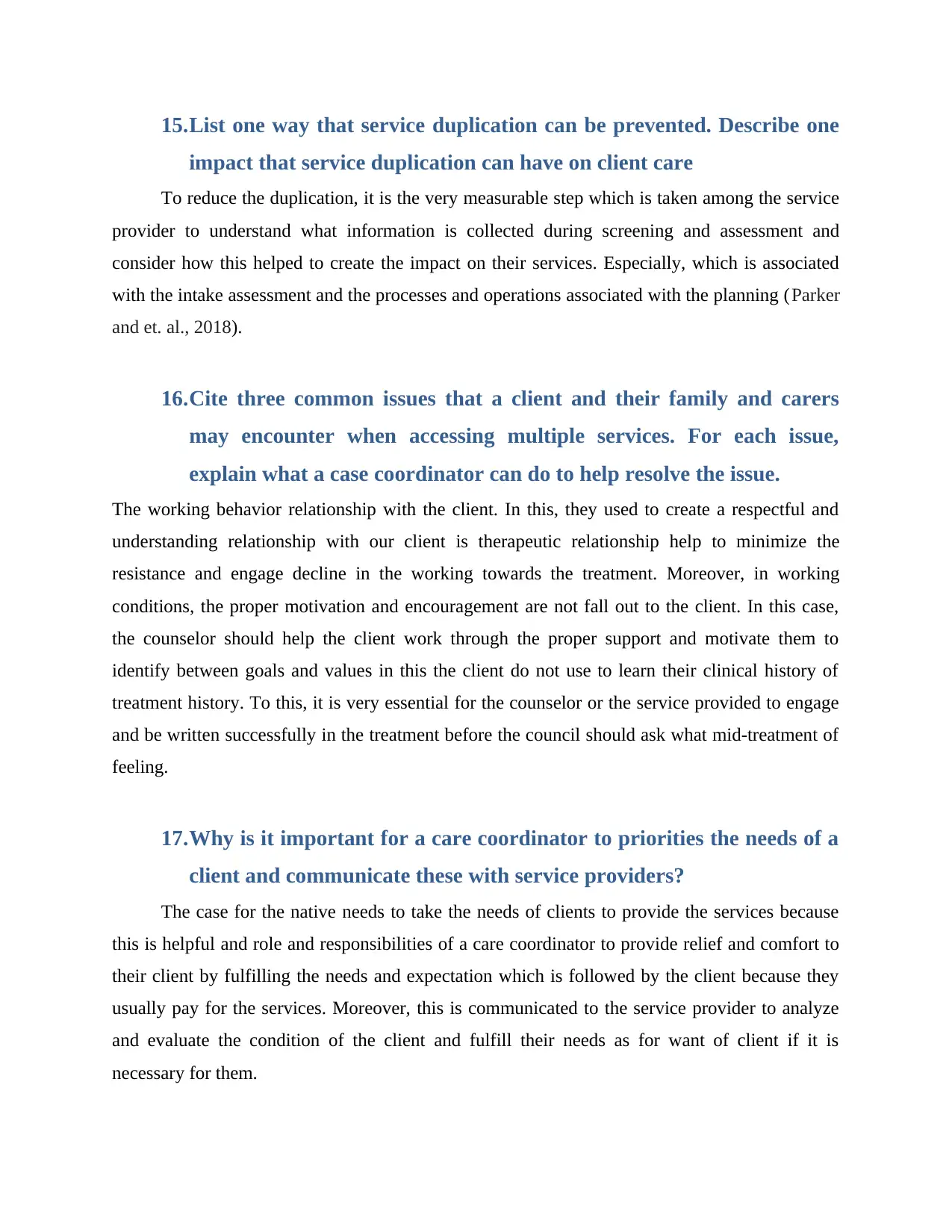
15.List one way that service duplication can be prevented. Describe one
impact that service duplication can have on client care
To reduce the duplication, it is the very measurable step which is taken among the service
provider to understand what information is collected during screening and assessment and
consider how this helped to create the impact on their services. Especially, which is associated
with the intake assessment and the processes and operations associated with the planning (Parker
and et. al., 2018).
16.Cite three common issues that a client and their family and carers
may encounter when accessing multiple services. For each issue,
explain what a case coordinator can do to help resolve the issue.
The working behavior relationship with the client. In this, they used to create a respectful and
understanding relationship with our client is therapeutic relationship help to minimize the
resistance and engage decline in the working towards the treatment. Moreover, in working
conditions, the proper motivation and encouragement are not fall out to the client. In this case,
the counselor should help the client work through the proper support and motivate them to
identify between goals and values in this the client do not use to learn their clinical history of
treatment history. To this, it is very essential for the counselor or the service provided to engage
and be written successfully in the treatment before the council should ask what mid-treatment of
feeling.
17.Why is it important for a care coordinator to priorities the needs of a
client and communicate these with service providers?
The case for the native needs to take the needs of clients to provide the services because
this is helpful and role and responsibilities of a care coordinator to provide relief and comfort to
their client by fulfilling the needs and expectation which is followed by the client because they
usually pay for the services. Moreover, this is communicated to the service provider to analyze
and evaluate the condition of the client and fulfill their needs as for want of client if it is
necessary for them.
impact that service duplication can have on client care
To reduce the duplication, it is the very measurable step which is taken among the service
provider to understand what information is collected during screening and assessment and
consider how this helped to create the impact on their services. Especially, which is associated
with the intake assessment and the processes and operations associated with the planning (Parker
and et. al., 2018).
16.Cite three common issues that a client and their family and carers
may encounter when accessing multiple services. For each issue,
explain what a case coordinator can do to help resolve the issue.
The working behavior relationship with the client. In this, they used to create a respectful and
understanding relationship with our client is therapeutic relationship help to minimize the
resistance and engage decline in the working towards the treatment. Moreover, in working
conditions, the proper motivation and encouragement are not fall out to the client. In this case,
the counselor should help the client work through the proper support and motivate them to
identify between goals and values in this the client do not use to learn their clinical history of
treatment history. To this, it is very essential for the counselor or the service provided to engage
and be written successfully in the treatment before the council should ask what mid-treatment of
feeling.
17.Why is it important for a care coordinator to priorities the needs of a
client and communicate these with service providers?
The case for the native needs to take the needs of clients to provide the services because
this is helpful and role and responsibilities of a care coordinator to provide relief and comfort to
their client by fulfilling the needs and expectation which is followed by the client because they
usually pay for the services. Moreover, this is communicated to the service provider to analyze
and evaluate the condition of the client and fulfill their needs as for want of client if it is
necessary for them.
⊘ This is a preview!⊘
Do you want full access?
Subscribe today to unlock all pages.

Trusted by 1+ million students worldwide
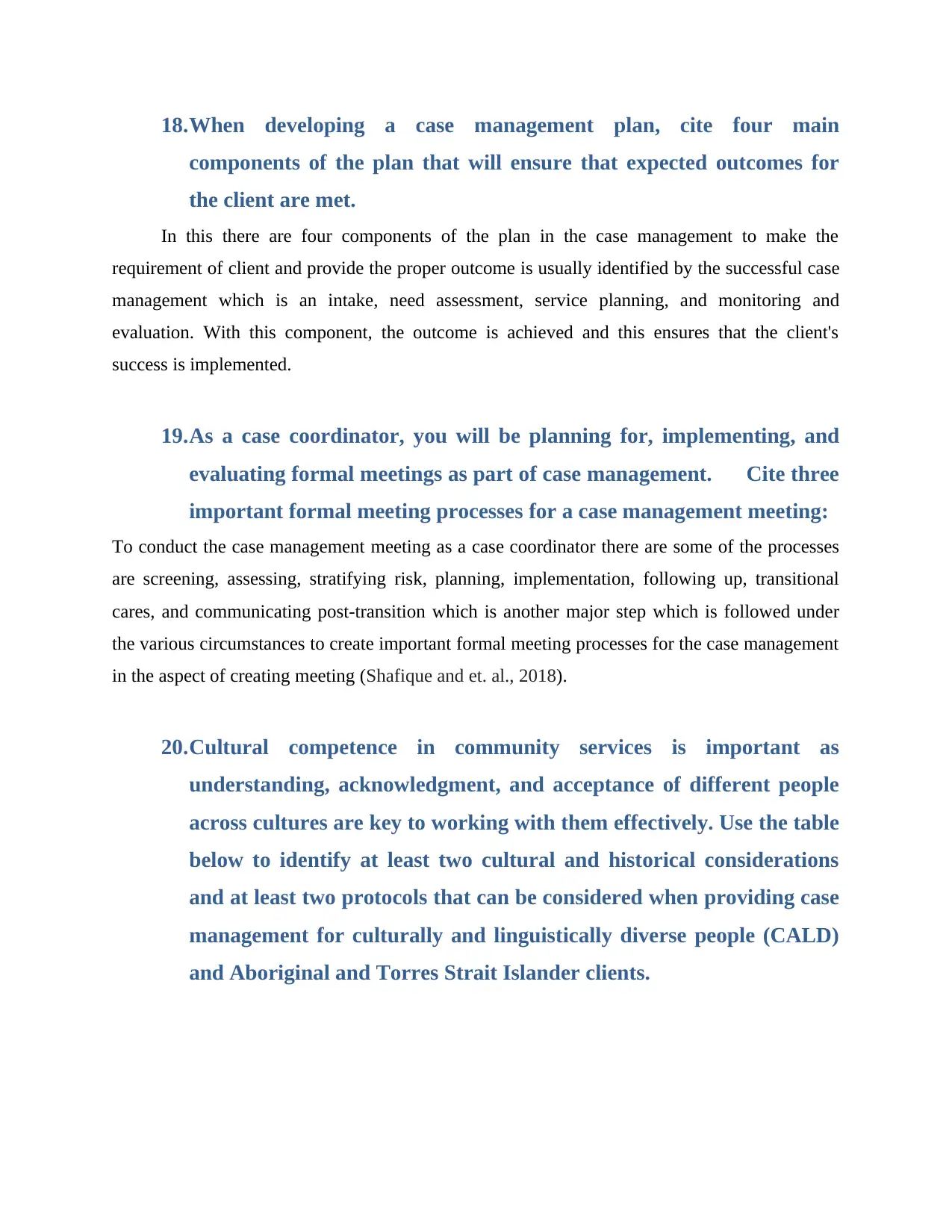
18.When developing a case management plan, cite four main
components of the plan that will ensure that expected outcomes for
the client are met.
In this there are four components of the plan in the case management to make the
requirement of client and provide the proper outcome is usually identified by the successful case
management which is an intake, need assessment, service planning, and monitoring and
evaluation. With this component, the outcome is achieved and this ensures that the client's
success is implemented.
19.As a case coordinator, you will be planning for, implementing, and
evaluating formal meetings as part of case management. Cite three
important formal meeting processes for a case management meeting:
To conduct the case management meeting as a case coordinator there are some of the processes
are screening, assessing, stratifying risk, planning, implementation, following up, transitional
cares, and communicating post-transition which is another major step which is followed under
the various circumstances to create important formal meeting processes for the case management
in the aspect of creating meeting (Shafique and et. al., 2018).
20.Cultural competence in community services is important as
understanding, acknowledgment, and acceptance of different people
across cultures are key to working with them effectively. Use the table
below to identify at least two cultural and historical considerations
and at least two protocols that can be considered when providing case
management for culturally and linguistically diverse people (CALD)
and Aboriginal and Torres Strait Islander clients.
components of the plan that will ensure that expected outcomes for
the client are met.
In this there are four components of the plan in the case management to make the
requirement of client and provide the proper outcome is usually identified by the successful case
management which is an intake, need assessment, service planning, and monitoring and
evaluation. With this component, the outcome is achieved and this ensures that the client's
success is implemented.
19.As a case coordinator, you will be planning for, implementing, and
evaluating formal meetings as part of case management. Cite three
important formal meeting processes for a case management meeting:
To conduct the case management meeting as a case coordinator there are some of the processes
are screening, assessing, stratifying risk, planning, implementation, following up, transitional
cares, and communicating post-transition which is another major step which is followed under
the various circumstances to create important formal meeting processes for the case management
in the aspect of creating meeting (Shafique and et. al., 2018).
20.Cultural competence in community services is important as
understanding, acknowledgment, and acceptance of different people
across cultures are key to working with them effectively. Use the table
below to identify at least two cultural and historical considerations
and at least two protocols that can be considered when providing case
management for culturally and linguistically diverse people (CALD)
and Aboriginal and Torres Strait Islander clients.
Paraphrase This Document
Need a fresh take? Get an instant paraphrase of this document with our AI Paraphraser
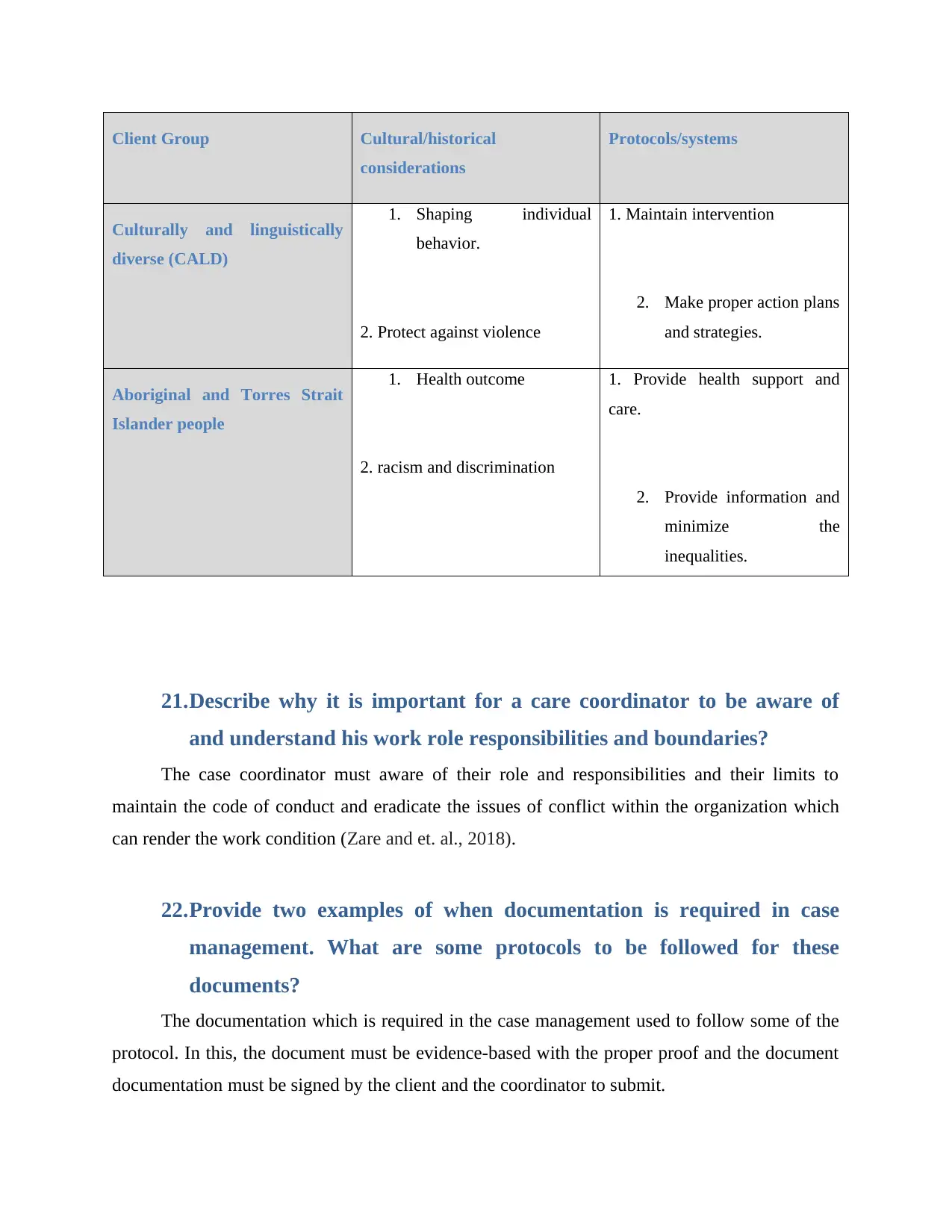
Client Group Cultural/historical
considerations
Protocols/systems
Culturally and linguistically
diverse (CALD)
1. Shaping individual
behavior.
2. Protect against violence
1. Maintain intervention
2. Make proper action plans
and strategies.
Aboriginal and Torres Strait
Islander people
1. Health outcome
2. racism and discrimination
1. Provide health support and
care.
2. Provide information and
minimize the
inequalities.
21.Describe why it is important for a care coordinator to be aware of
and understand his work role responsibilities and boundaries?
The case coordinator must aware of their role and responsibilities and their limits to
maintain the code of conduct and eradicate the issues of conflict within the organization which
can render the work condition (Zare and et. al., 2018).
22.Provide two examples of when documentation is required in case
management. What are some protocols to be followed for these
documents?
The documentation which is required in the case management used to follow some of the
protocol. In this, the document must be evidence-based with the proper proof and the document
documentation must be signed by the client and the coordinator to submit.
considerations
Protocols/systems
Culturally and linguistically
diverse (CALD)
1. Shaping individual
behavior.
2. Protect against violence
1. Maintain intervention
2. Make proper action plans
and strategies.
Aboriginal and Torres Strait
Islander people
1. Health outcome
2. racism and discrimination
1. Provide health support and
care.
2. Provide information and
minimize the
inequalities.
21.Describe why it is important for a care coordinator to be aware of
and understand his work role responsibilities and boundaries?
The case coordinator must aware of their role and responsibilities and their limits to
maintain the code of conduct and eradicate the issues of conflict within the organization which
can render the work condition (Zare and et. al., 2018).
22.Provide two examples of when documentation is required in case
management. What are some protocols to be followed for these
documents?
The documentation which is required in the case management used to follow some of the
protocol. In this, the document must be evidence-based with the proper proof and the document
documentation must be signed by the client and the coordinator to submit.
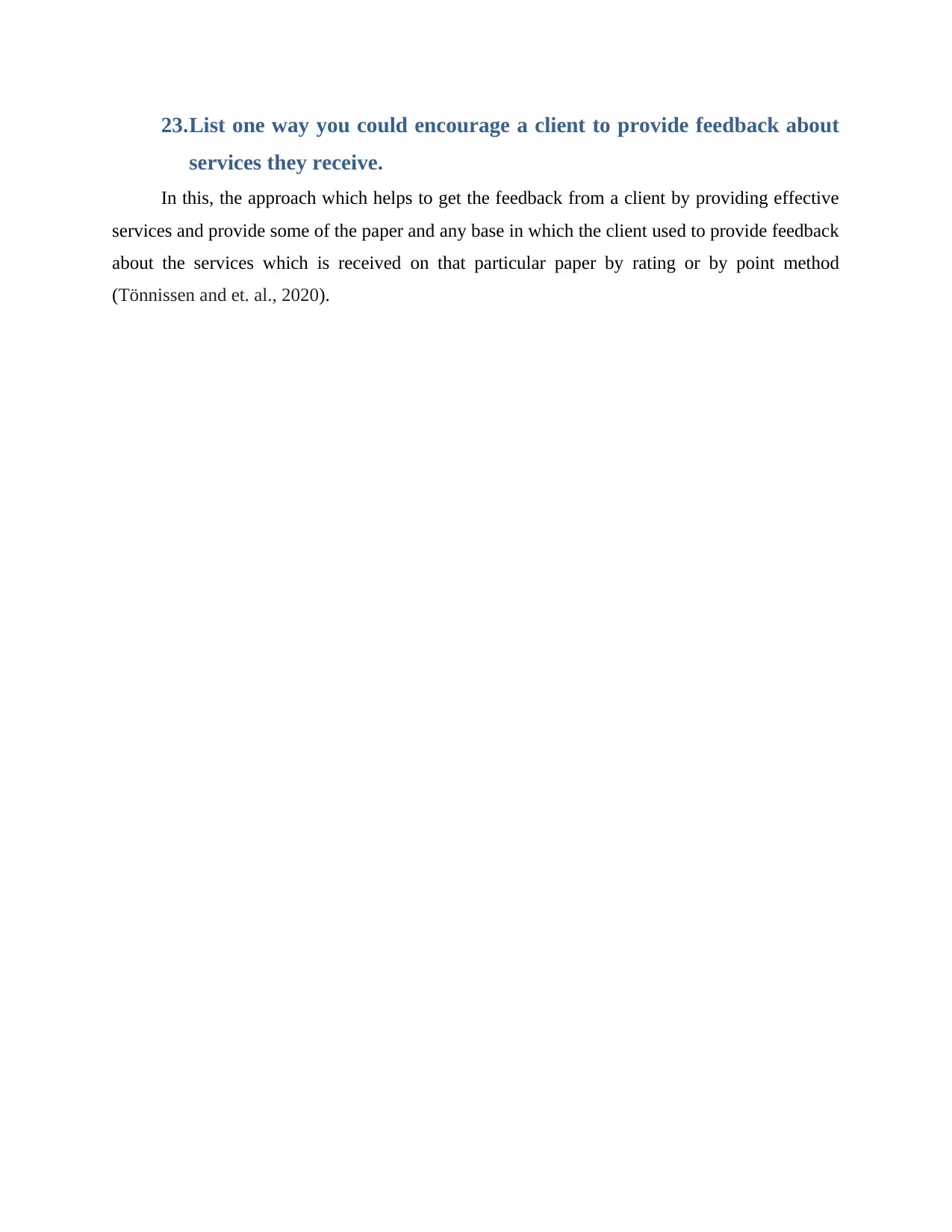
23.List one way you could encourage a client to provide feedback about
services they receive.
In this, the approach which helps to get the feedback from a client by providing effective
services and provide some of the paper and any base in which the client used to provide feedback
about the services which is received on that particular paper by rating or by point method
(Tönnissen and et. al., 2020).
services they receive.
In this, the approach which helps to get the feedback from a client by providing effective
services and provide some of the paper and any base in which the client used to provide feedback
about the services which is received on that particular paper by rating or by point method
(Tönnissen and et. al., 2020).
⊘ This is a preview!⊘
Do you want full access?
Subscribe today to unlock all pages.

Trusted by 1+ million students worldwide
1 out of 13
Related Documents
Your All-in-One AI-Powered Toolkit for Academic Success.
+13062052269
info@desklib.com
Available 24*7 on WhatsApp / Email
![[object Object]](/_next/static/media/star-bottom.7253800d.svg)
Unlock your academic potential
Copyright © 2020–2025 A2Z Services. All Rights Reserved. Developed and managed by ZUCOL.




